Highly Sustainable and Completely Amorphous Hierarchical Ceramide Microcapsules for Potential Epidermal Barrier
Abstract
:1. Introduction
2. Materials and Methods
2.1. Materials
2.2. Synthesis of Hierarchical Amorphous Ceramide Microcapsule
2.3. Characterization
3. Results and Discussion
3.1. Structural Characterization of Hierarchical Amorphous Ceramide Microcapsule
3.2. Morphological Properties of Hierarchical Amorphous Ceramide Microcapsule
3.3. Long-Term Stability of Hierarchical Amorphous Ceramide Microcapsule
4. Conclusions
Author Contributions
Funding
Conflicts of Interest
References
- Natarajan, V.T.; Ganju, P.; Ramkumar, A.; Grover, R.; Gokhale, R.S. Multifaceted Pathways Protect Human Skin from UV Radiation. Nat. Chem. Biol. 2014, 10, 542. [Google Scholar] [CrossRef]
- Bouwstra, J.A.; Dubbelaar, F.E.R.; Gooris, G.S.; Weerheim, A.M.; Ponec, M. The Role of Ceramide Composition in the Lipid Organisation of the Skin Barrier. Biochim. Biophys. Acta 1999, 1419, 127–136. [Google Scholar] [CrossRef] [Green Version]
- Cha, H.J.; He, C.; Zhao, H.; Dong, Y.; An, I.; An, S. Intercellular and Intracellular Functions of Ceramides and Their Metabolites in Skin. Mol. Med. 2016, 38, 16–22. [Google Scholar] [CrossRef] [Green Version]
- De Paepe, K.; Derde, M.P.; Roseeuw, D.; Rogiers, V.J. Incorporation of Ceramide 3B in Dermatocosmetic Emulsions: Effect on the Transepidermal Water Loss of Sodium Lauryl Sulphatedamaged Skin. Eur. Acad. Dermatol. Venereol. 2000, 14, 272–279. [Google Scholar] [CrossRef]
- Rawlings, A.V. Trends in Stratum Corneum Research and the Management of Dry Skin Conditions. A. Int. J. Cosmet. Sci. 2003, 25, 63–95. [Google Scholar] [CrossRef]
- Shimada, K.; Yoon, J.; Yoshihara, T.; Iwasaki, T.; Nishifuji, K. Increased Transepidermal Water Loss and Decreased Ceramide Content in Lesional and Non-lesional Skin of Dogs with Atopic Dermatitis. Vet. Dermatol. 2009, 20, 541–546. [Google Scholar] [CrossRef] [PubMed]
- Motta, S.; Monti, M.; Sesana, S.; Mellesi, L.; Ghidoni, R.; Caputo, R. Abnormality of Water Barrier Function in Psoriasis. Arch. Dermatol. 1994, 130, 452–456. [Google Scholar] [CrossRef] [PubMed]
- Rawlings, A.V.; Scott, I.R.; Harding, C.R.; Bowser, P.A. Stratum Corneum Moisturization at the Molecular Level. J. Invest. Dermatol. 1994, 103, 731–740. [Google Scholar] [CrossRef] [PubMed] [Green Version]
- Liu, Y.; Goff, R.D.; Zhou, D.; Mattner, J.; Sullivan, B.A.; Khurana, A.; Cantu, C., III; Ravkov, E.V.; Ibegbu, C.C.; Altman, J.D.; et al. A Modified α-Galactosyl Ceramide for Staining and Stimulating Natural Killer T Cells. J. Immunol. Methods 2006, 312, 34–39. [Google Scholar] [CrossRef]
- Dobrowsky, R.T.; Hannun, Y.A. Ceramide Stimulates a Cytosolic Protein Phosphatas. J. Biol. Chem. 1992, 267, 5048–5051. [Google Scholar]
- Nazzaro, F.; Orlando, P.; Fratianni, F.; Coppola, R. Microencapsulation in Food Science and Biotechnology. Curr. Opin. Biotechnol. 2012, 23, 182–186. [Google Scholar] [CrossRef] [PubMed]
- Martins, I.M.; Barreiro, M.F.; Coelho, M.; Rodrigues, A.E. Microencapsulation of Essential Oils with Biodegradable Polymeric Carriers for Cosmetic Applications. Chem. Eng. J. 2014, 245, 191–200. [Google Scholar] [CrossRef] [Green Version]
- Desai, K.G.H.; Park, H.J. Recent Developments in Microencapsulation of Food Ingredients. Dry. Technol. 2005, 23, 1361–1394. [Google Scholar] [CrossRef]
- Miyazawa, K.; Yajima, I.; Kaneda, I.; Yanaki, T. Preparation of a New Soft Capsule for Cosmetics. J. Cosmet. Sci. 2000, 51, 239–252. [Google Scholar]
- Nelson, G. Application of Microencapsulation in Textiles. Int. J. Pharm. 2002, 242, 55–62. [Google Scholar] [CrossRef]
- Ahangaran, F.; Navarchian, A.H.; Picchioni, F. Material Encapsulation in Poly(methyl methacrylate) Shell: A Review. J. Appl. Polym. Sci. 2019, 136, 48039. [Google Scholar] [CrossRef] [Green Version]
- Pan, X.; Mercadeé-Prieto, R.; York, D.; Preece, J.A.; Zhang, Z. Structure and Mechanical Properties of Consumer-Friendly PMMA Microcapsules. Ind. Eng. Chem. Res. 2013, 52, 11253–11265. [Google Scholar] [CrossRef]
- Ali, U.; Karim, K.J.; Karim, B.A.; Buang, N.A. A Review of the Properties and Applications of Poly (Methyl Methacrylate) (PMMA). Polym. Rev. 2015, 55, 678–705. [Google Scholar] [CrossRef]
- Carrer, D.C.; Maggio, B. Transduction to Self-assembly of Molecular Geometry and Local Interactions in Mixtures of Ceramides and Ganglioside GM1. Biochim. Biophys. Acta 2001, 1514, 87–99. [Google Scholar] [CrossRef] [Green Version]
- Salim, M.; Minamikawa, H.; Sugimura, A.; Hashim, R. Amphiphilic Designer Nano-carriers for Controlled Release, from Drug Delivery to Diagnostics. Med. Chem. Comm. 2014, 5, 1602–1618. [Google Scholar] [CrossRef]
- Israelachvili, J.N. Intermolecular and Surface forces, 3rd ed.; Academic Press: Santa Barbara, CA, USA, 2011. [Google Scholar]
- Lantzch, G.; Binder, H.; Heerklotz, H.; Wendling, M.; Klose, G. Surface Areas and Packing Constraints in POPC/C12EOn Membranes. A Time-resolved Fluorescence Study. Biophys. Chem. 1996, 58, 289–302. [Google Scholar] [CrossRef]
- Kronberg, B.; Lindman, B. Surfactants and Polymers in Aqueous Solution, 2nd ed.; John Wiley & Sons Ltd.: Chichester, UK, 2003. [Google Scholar]
- Israelachvili, J. The Science and Applications of Emulsions—An Overview. Colloids Surf. Physicochem. Eng. Aspects 1994, 91, 1–8. [Google Scholar] [CrossRef]
- Shrestha, R.G.; Nomura, K.; Yamamoto, M.; Yamawaki, Y.; Tamura, Y.; Sakai, K.; Sakamoto, K.; Sakai, H.; Abe, M. Peptide-Based Gemini Amphiphiles: Phase Behavior and Rheology of Wormlike Micelles. Langmuir 2012, 28, 15472–15481. [Google Scholar] [CrossRef]
- Jeong, K.Y.; Lee, D.K. Influence of Ceramide III on the Structure of a Phospholipid Lamellar Liquid Crystalline Phase Hydrated in Glycerin: Structural and Thermal Behaviors. Appl. Chem. Eng. 2010, 21, 603–609. [Google Scholar]
- Hikima, T.; Tamura, Y.; Yamawaki, Y.; Yamamoto, M.; Tojo, K. Skin Accumulation and Penetration of a Hydrophilic Compound by a Novel Gemini Surfactant, Sodium Dilauramidoglutamide Lysine. Int. J. Pharm. 2013, 443, 288–292. [Google Scholar] [CrossRef] [PubMed]
- Pan, K.; Zhong, Q.; Baek, S.J. Enhanced Dispersibility and Bioactivity of Curcumin by Encapsulation in Casein Nanocapsules. J. Agric. Food Chem. 2013, 61, 6036–6043. [Google Scholar] [CrossRef] [PubMed]
- Peng, S.; Li, Z.; Zou, L.; Liu, W.; Liu, C.; McClements, D.J. Improving Curcumin Solubility and Bioavailability by Encapsulation in Saponin-coated Curcumin Nanoparticles Prepared Using a Simple pH-driven Loading Method. Food Funct. 2018, 9, 1829–1839. [Google Scholar] [CrossRef] [PubMed]
- Garidel, P. Calorimetric and Spectroscopic Investigations of Phytosphingosine Ceramide Membrane Organisation. Phys. Chem. Chem. Phys. 2002, 4, 1934–1942. [Google Scholar] [CrossRef]
- Toro-Mendoza, J.; Petsev, D.N. Brownian Dynamics of Emulsion Film Formation and Droplet Coalescence. Phys. Rev. E 2010, 81, 051404. [Google Scholar] [CrossRef]
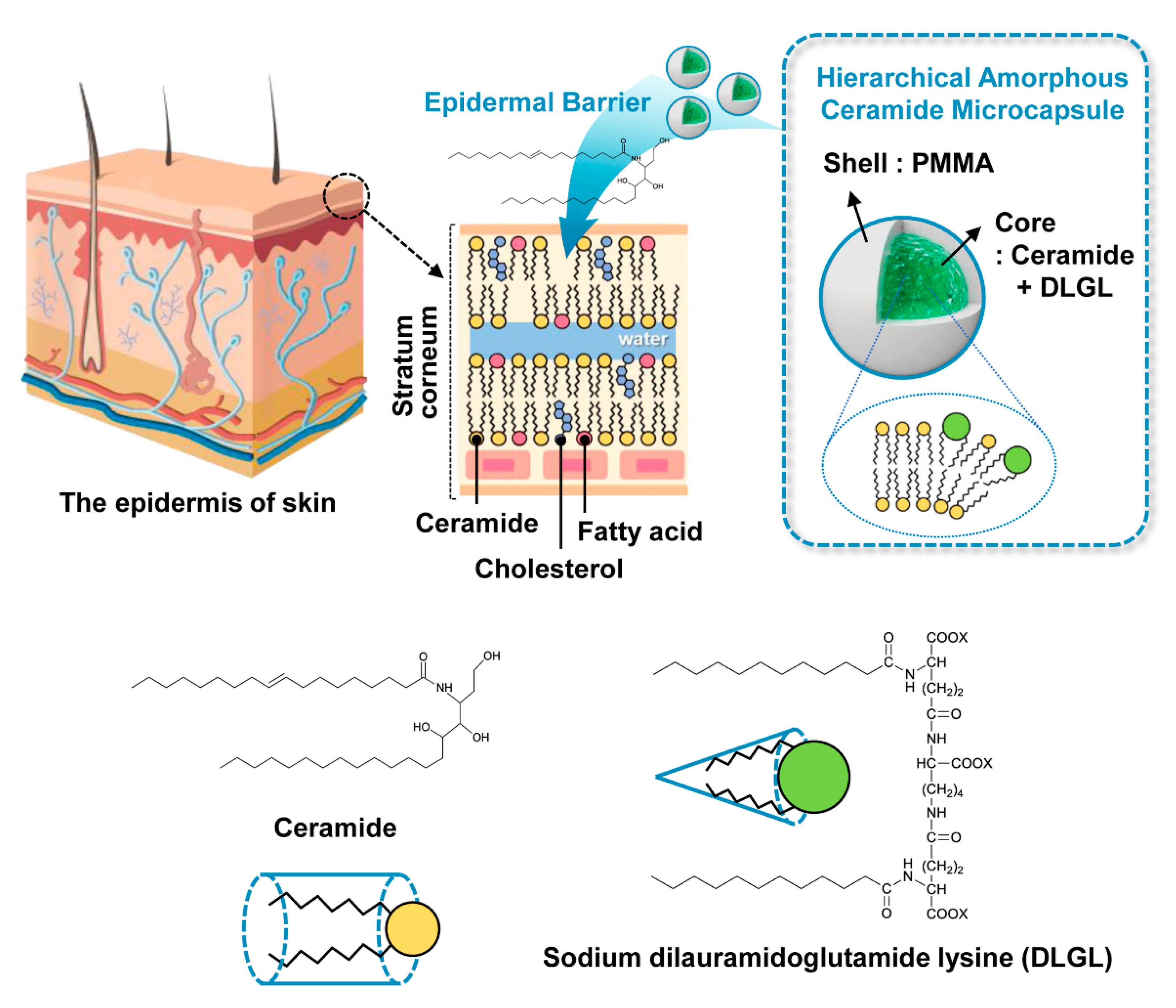

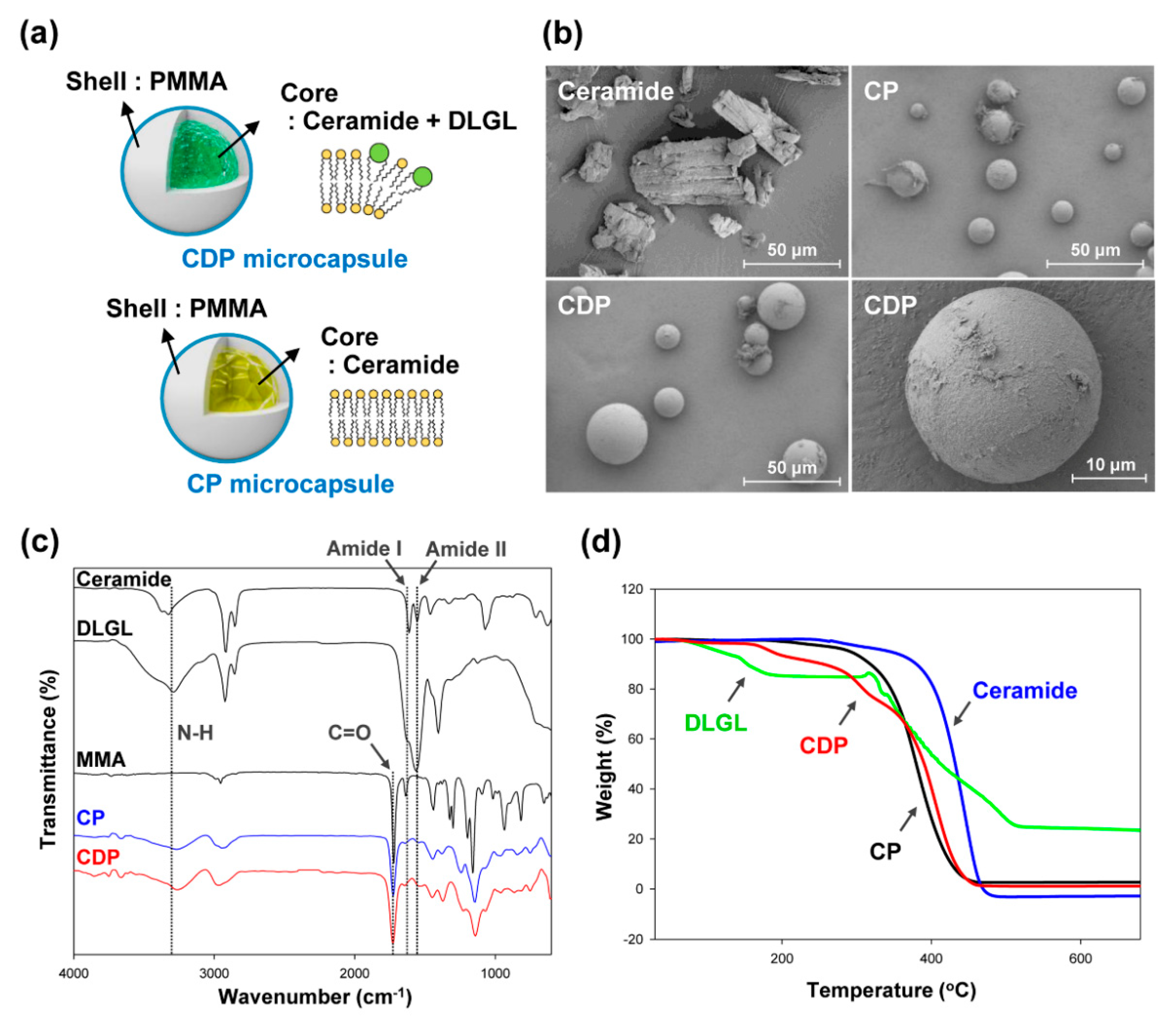
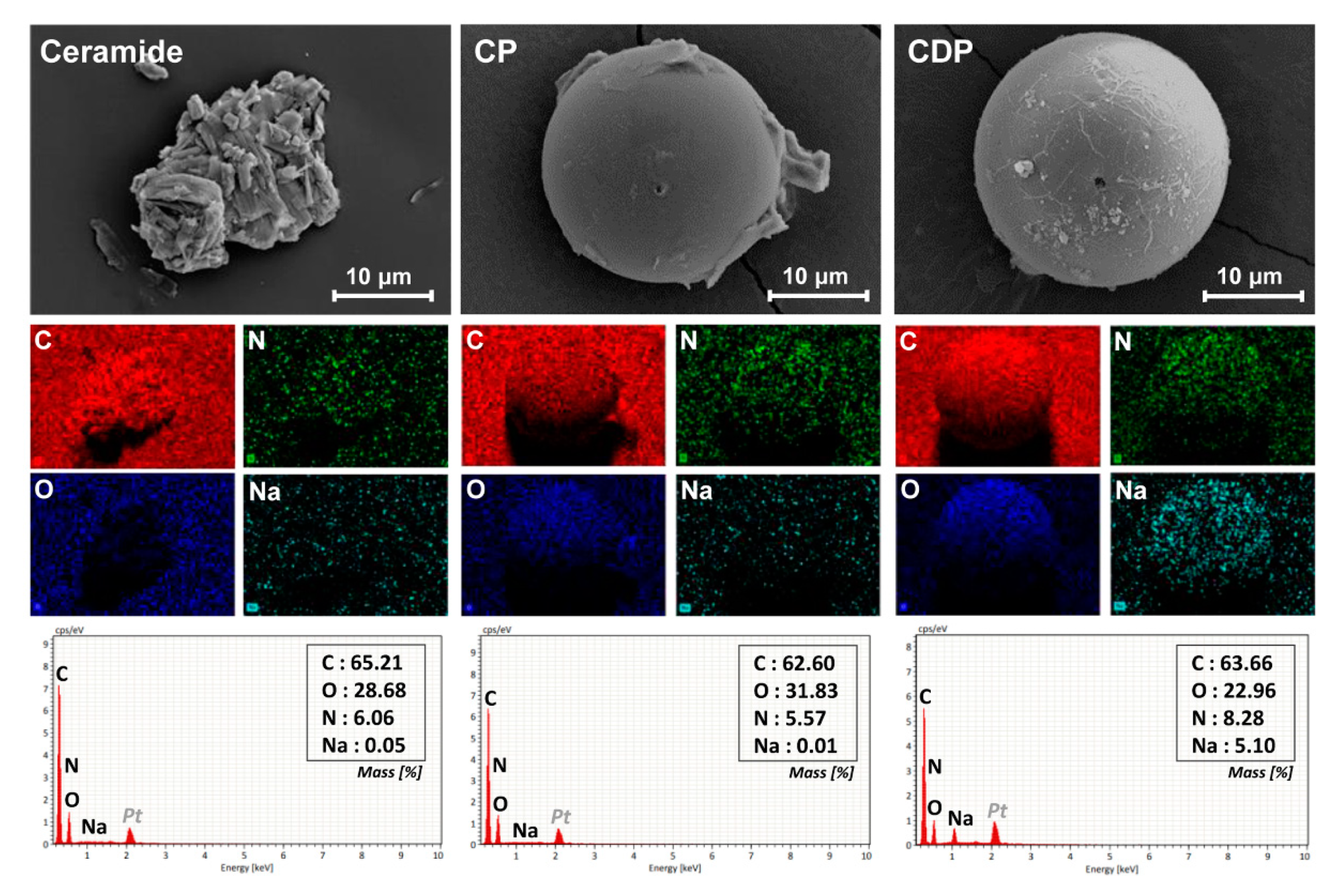

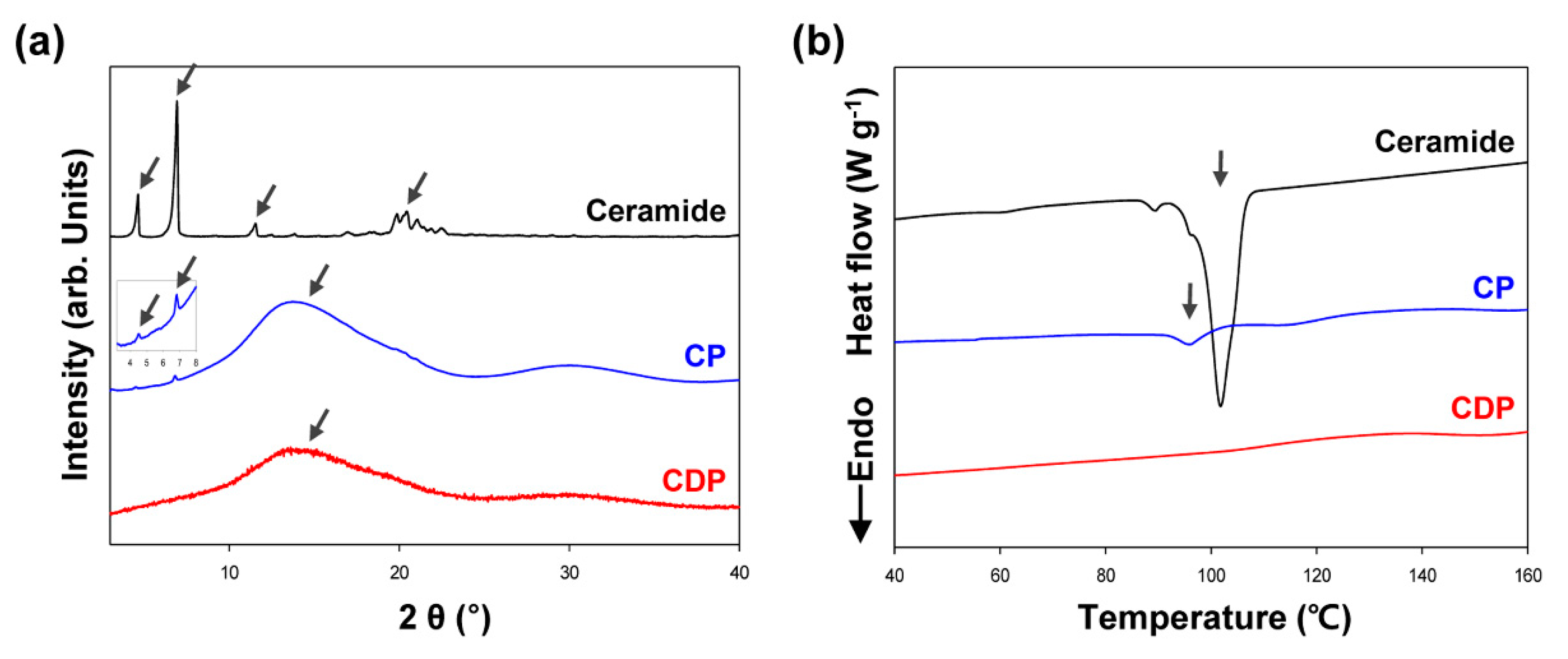
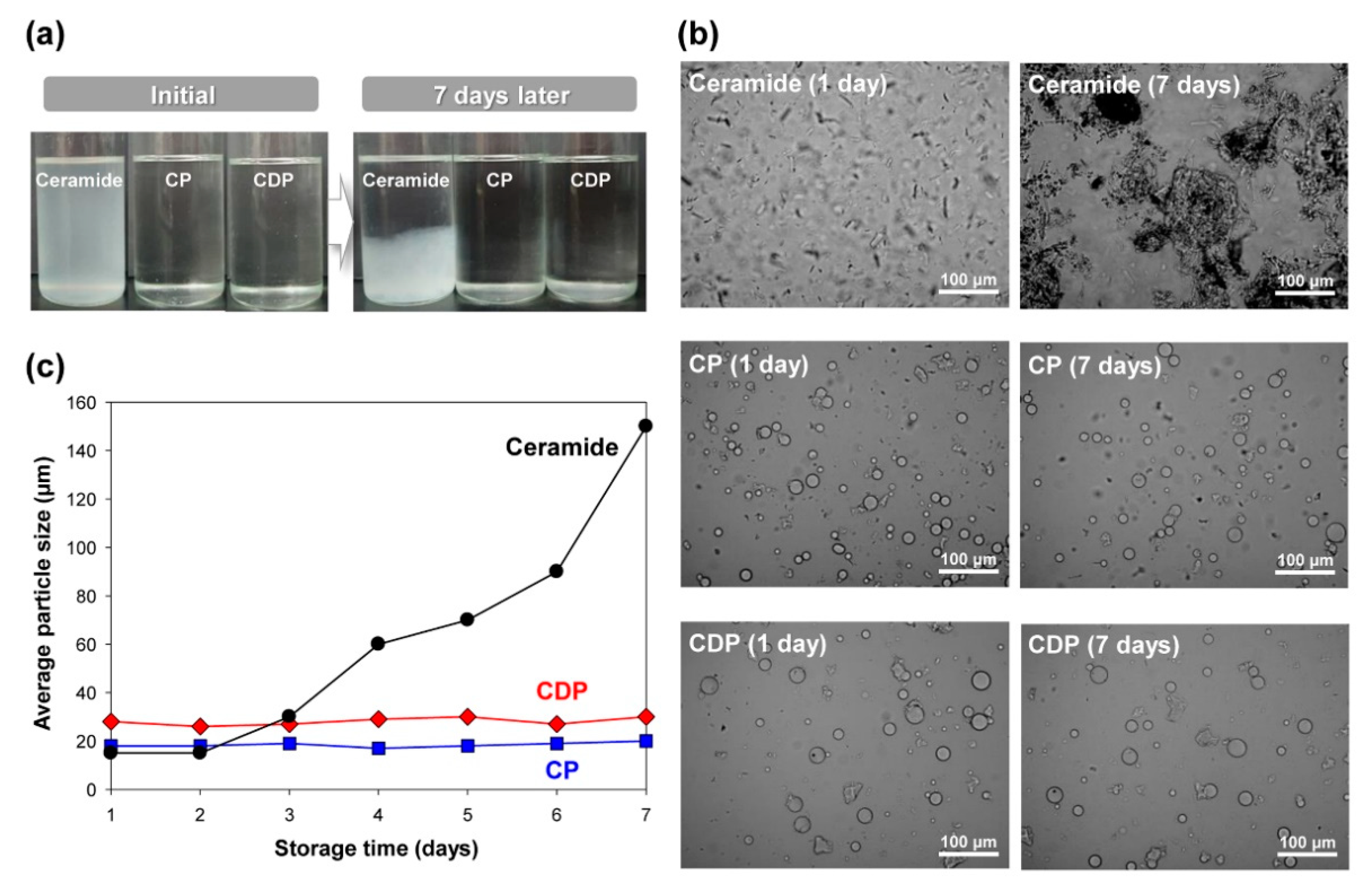
© 2020 by the authors. Licensee MDPI, Basel, Switzerland. This article is an open access article distributed under the terms and conditions of the Creative Commons Attribution (CC BY) license (http://creativecommons.org/licenses/by/4.0/).
Share and Cite
Yoon, J.; Noh, M.; Lee, J.B.; Lee, J.H. Highly Sustainable and Completely Amorphous Hierarchical Ceramide Microcapsules for Potential Epidermal Barrier. Polymers 2020, 12, 2166. https://doi.org/10.3390/polym12092166
Yoon J, Noh M, Lee JB, Lee JH. Highly Sustainable and Completely Amorphous Hierarchical Ceramide Microcapsules for Potential Epidermal Barrier. Polymers. 2020; 12(9):2166. https://doi.org/10.3390/polym12092166
Chicago/Turabian StyleYoon, Joonsik, Minjoo Noh, Jun Bae Lee, and Jun Hyup Lee. 2020. "Highly Sustainable and Completely Amorphous Hierarchical Ceramide Microcapsules for Potential Epidermal Barrier" Polymers 12, no. 9: 2166. https://doi.org/10.3390/polym12092166
APA StyleYoon, J., Noh, M., Lee, J. B., & Lee, J. H. (2020). Highly Sustainable and Completely Amorphous Hierarchical Ceramide Microcapsules for Potential Epidermal Barrier. Polymers, 12(9), 2166. https://doi.org/10.3390/polym12092166



